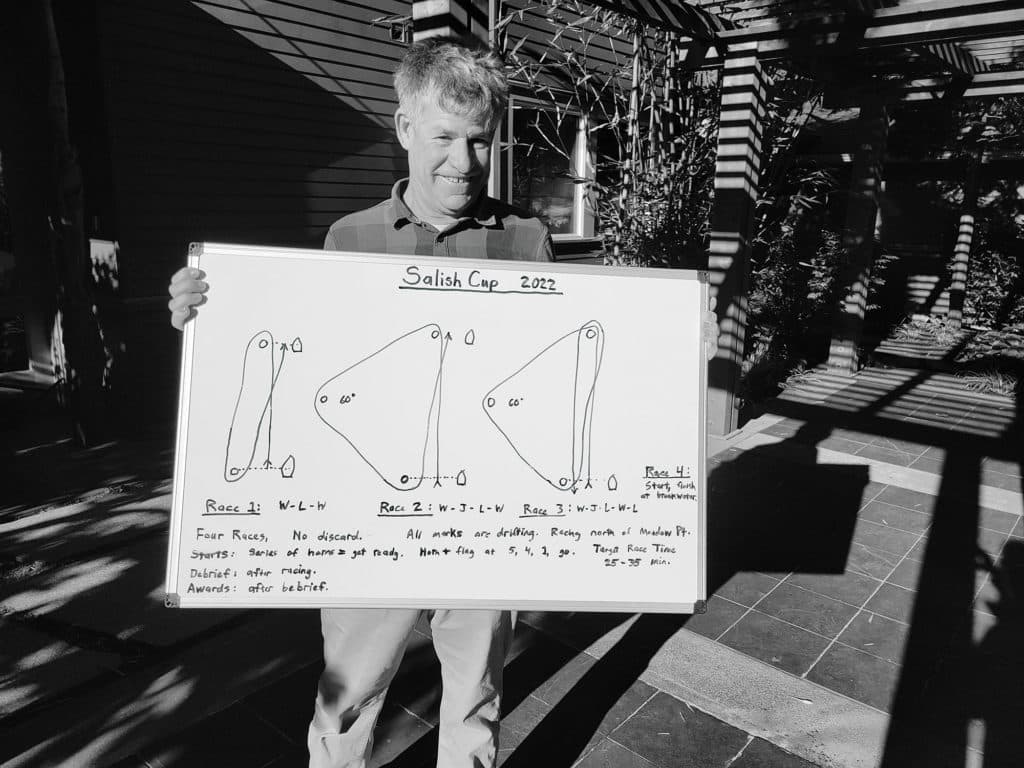
The first time I went to a bush regatta was the 1986 Tasar British Columbia Championship at Lake Cultus. The scene was new to me: camping, bonfires, barbecues, lake racing. I was hooked.
When my team went to Australia to race 18-foot skiffs the following year, it was obvious we were way behind the other teams. We needed more practice racing to be competitive and came up with an idea to host informal racing every Tuesday night. We borrowed a 12-foot “tinny” and made marks with plastic milk bottles lashed together. We sailed in the small confines of Balmoral Bay in Sydney, primarily for boathandling practice, but also because our anchor lines were not very long.
At first, only one team joined us, but a month later we had the top boats racing around our little makeshift course. We started calling it the Balmoral Cup. Everyone had a great time, learned a thing or two, and enjoyed the casual camaraderie. In the years since, we have created regattas around the Pacific Northwest using the same principle of simplified infrastructure.
How do we run a quality event with minimal infrastructure? I have some ideas based on our experience in the northwest Tasar class. First, bush regattas work best with only one class, or two at the most. You want to maximize the racing and minimize the waiting. Having the right race committee is important. We find someone within our fleet who cannot sail or an alum. Having a spouse or second person on the committee boat is ideal.
Communication has to be simple and direct. We use our fleet’s email Listserv to post an informal “notice of race” that includes the location, time and camping details. Give the event a cool name to make it more unique. We use a whiteboard to explain the course and have a short briefing before the first race. The race committee can make updates by hail on the water.
Use a simplified flag system for the start. For example, at five minutes, a red flag goes up on one end of a 6-foot pole (or batten). At four minutes, the pole is reversed, and the blue flag is displayed. At one minute, the blue flag comes down, and the red flag goes back up at the start.
There are two primary racecourse considerations dictated by depth. If the water is shallow, say less than 100 feet, we anchor the marks and committee boat in the traditional fashion. If the water is deep, as is often true in the Pacific Northwest, you can use drifting marks. We attach a laundry basket or milk crate to the mark instead of an anchor. The mark will drift a little, but the course geometry will remain constant. We have found this does not detract from the fairness of the race. It is as if there was a little upwind current. Likewise, the race-committee boat can motor to maintain position on the start and finish lines, keeping a steady bearing on the mark.
The committee boat can be small. Ideally, it should safely hold two people plus three buoys. We have used aluminum fishing boats, RIBs and small trailerable fishing boats as small as 11 feet. The marks can be inflatable, but round orange balls also work fine and have less windage. The only other RC gear required is a flag, a notepad and a horn.
Keep the courses simple. We normally use all three buoys, allowing for either windward-leewards or triangles, with the finish either to windward or leeward. If you are using the deepwater setup, finish upwind because the course slowly drifts to leeward and you can recenter the location.
A post-race debrief is always part or our events. We hand out casual repurposed or handmade trophies, then we have a debrief where the fast boats share tips and everyone learns something for next time. We are especially conscious of improving the boats at the back of the fleet to keep them coming back. If it is a two-day regatta, we have a debrief after each day.
Our preference is for a two-day event, mostly because this allows us to have a great social event on Saturday night. If the venue involves camping, as many of ours do, this is especially true. However, a one-day event can also be satisfying, especially if it is a short drive from home. This also keeps costs down because racers don’t need accommodations or restaurant meals. At some venues where there’s wind all day and easy launching, it is nice to have a lunch break. In this case, a good program is two morning races, then lunch, then two more afternoon races. If the location is a long drive from home, we normally have a later start on the first day to allow Saturday morning travel, then an earlier start the second day.
Race length is at the group’s discretion. We sometimes have a lot of short aces, especially if the lake is small. We prefer slightly longer courses, say 30 to 40 minutes per race. Sometimes the venue is conducive to a long-distance race. This doesn’t have to be a marathon, but a one-hour race—maybe going to a different part of the lake—can be a nice change of pace.
The best thing about a DIY regatta is that by venturing out to a new lake or a new bay, you might be surprised by how much fun you can have and how easy it is. There are a lot of neat mountain lakes and saltwater inlets with decent wind where we live, but there are never regattas there because there is no infrastructure. I always learn new things and have a good time at a new place. There is a sense of discovery, especially at a location that has never held a regatta. The change will do you good.









